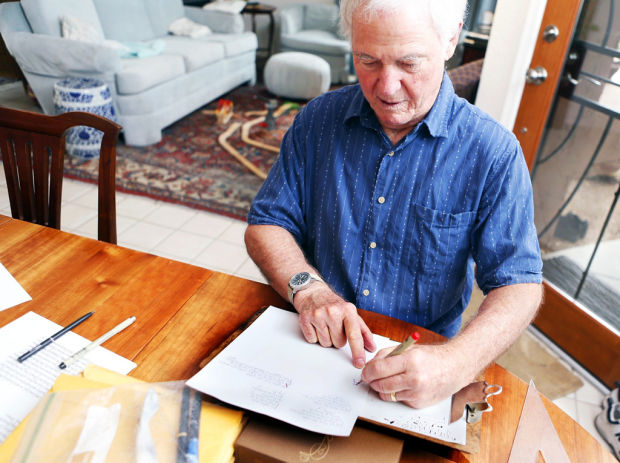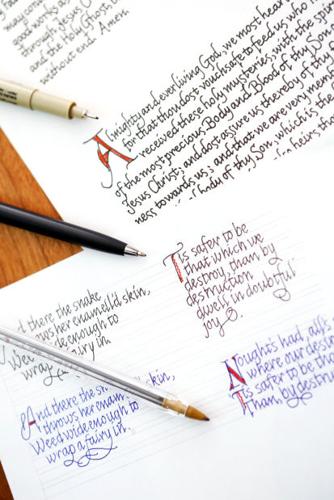W. John Cocke devoted decades to exploring the cosmos through equations and cutting-edge telescopes.
At home, however, the astrophysicist's passion has been calligraphy, or "beautiful writing"in Greek.
"I've always been very fond of graphics," said Cocke, now 75 and a retired University of Arizona astronomy professor. "With astronomy, you have these beautiful photos of stuff that's happening in outer space."
That love of form initially attracted him to Chinese calligraphy, and then medieval calligraphy, which he practiced until he felt he understood the art.
In 1978, after several years of practice, Cocke undertook a project few have attempted since the invention of the printing press in the 15th century - he used calligraphy to reproduce the first four books of the New Testament, using the King James Version of the Bible.
Setting aside time whenever he could, it took him until 1999 to complete the four Gospels.
His wife, Claire, saw the artistry in the project and her husband's humility about it. She prompted him to publish his work - an effort that would take nearly 13 years.
Cocke did some research and could find no other complete calligraphic version of the Gospels in modern English. Other handwritten copies, such as the St. John's Bible commissioned by St. John's Abbey and University in Minnesota and completed in 2011, have cropped up since then.
Ultimately, it was Claire who discovered the right publisher, Inkwell Productions based in Scottsdale.
"It's not a book about art," Claire explained. "It's art itself."
The final product showcases multiple styles of writing - some of the letters fluid, others rigid. In the Gospel of St. John, the telling of the crucifixion of Jesus outlines the shape of a cross.
The letters that swoop and swerve in "The Four Gospels: A Study in Calligraphy," Cocke's 378-page book, tell a familiar story in a fading form.
"(Calligraphy) is dying out, and people are not writing much by hand anymore," Cocke said. "They are doing texting and emailing, and if there is any kind of visual stuff going on, it's posting photos on Facebook."
• • •
Cocke's love of astronomy and calligraphy has rubbed off on his family. His son, daughter Caitlyn Johnston and three grandchildren all know a little about both passions. On a recent visit home, they piped in about pulsars and calligraphic scripts.
In her 20s, Cocke's daughter gave him a book on unicorns that featured modern calligraphy. The script in it became the inspiration for some of the style he used in the Gospel of St. John. The first few pages of that Gospel now hang in Cocke's childhood church in Asheville, N.C. - dedicated to his father who always treasured St. John and died before Cocke began his project.
Cocke did much of his calligraphy on an oak desk from the 1920s, but also enjoyed working out in the living room with family life whirling around him.
Still, with no delete key or pencil eraser, calligraphy takes serious focus.
His wife and daughter both laughed as they recalled that he would say, "I need 30 minutes of quiet!" as he picked up one of his fine italic fountain pens.
Big mistakes meant a scrapped page, and as a left-hander, Cocke had to pay extra attention to keep from smearing the ink as he moved across the page. On a good day, he could do one-third of a page in 30 minutes. He likened the process to working through math or physics problems.
"You can see a mathematical proof laid out on a page, and it may take you a few hours to work through, but the text is fascinating," Cocke said. "You can say the Bible is the Word of God, among other kinds (of sacred texts), but I think physics is also kind of the Word of God, because it's the way and the rails upon which the universe runs."
• • •
Cocke grew up in an Episcopalian church and still attends occasionally. Over the years, he and Claire, 69, have cultivated an interest in relaxing through meditation and seeking knowledge outside their immediate experiences.
"Any text has the potential of drawing you closer to God," Cocke said. "Of course, a lot of it doesn't, and this (project) wasn't intended to ... but as a handwritten prayer, part of its substance is divine."
The artistic formatting of a religious text complemented Cocke's career in science and math.
"He promoted the harmony between (religion and science)," said George Coyne, the retired director of the Vatican Observatory and a former colleague of Cocke's in the UA's astronomy department. "He saw Scripture as telling wonderful stories, and he wanted to record them in a way that people would sort of appreciate."
In the same way that people relish pulling handwritten birthday cards and notes from cluttered drawers to reminisce, Cocke anticipates people will enjoy reading a hand-scribed copy of the Gospels.
"There are a lot of Christians in this country who I think would be very inspired by this kind of thing," Cocke said. "It would lead them into reading the Bible with more attention. If you're not religious, you just have to think of it as an aesthetic experience, if you like it."
The rise in popularity of handwritten and calligraphic Bibles has to do with the appeal of imagery. Some copies also have pages decorated with illuminations-or colorful letters and images. These brush strokes add personal touches of beauty that mechanical type does not.
"If you mean what you say, you want to present it in the most beautiful way possible," said Tim Ternes, director of the St. John's Bible Project. "If you want this to have meaning for this generation and future generations, you need to get them out of this sterile container."
Today, Cocke has turned his attention from an ancient text to the everyday. He wants to bring handwriting back, and not just for special occasions. "Beautiful writing" can have a place anywhere, including the "Aloha" sign that Cocke penned to direct visitors to his front door.
Right now, he's working on mastering a calligraphic script that looks good when using a fine-point marker or ballpoint pen. He posts samples on Facebook, writing quotes from Shakespeare or prayers drafted with ordinary pens.
"Somehow, when you write something on paper, it has more of a lasting value and more of a true impact than if you text it or type it as an email," Cocke said. "You just like to look at something. It's like looking at a flower or a painting-Picasso or Monet. You can't rationalize it. You go outside, you look at the sunset, and wow!"
Contact reporter Johanna Willett at jwillett@azstarnet.com or 573-4357.
Copying the bible
Only a handful of other known scribes have recently taken on the challenge of reproducing the Bible by hand.
Six calligraphers finished the most distinct version, the St. John's Bible of St. John's Abbey and University in Minnesota, in 2011.
"Writing the Bible is what calligraphers have done for centuries," said Tim Ternes, director of the St. John's Bible Project. "The Islamic and Jewish traditions still have a culture of handwritten sacred texts. It was the Christians who gave up the handwritten manuscript culture after the printing press."
But some of the allure of writing and reading a handwritten Bible is coming back. Cocke is not the only one who feels he is "part of this continuum of scribes that was interrupted with the invention of the printing press." Several other individuals in recent years have tried their hands at tackling a part, or all, of the Bible.
With the corresponding revolutions of the printing press in the 15th century and the computer in the 20th century, taking the time to grab a paper and pen is increasingly unnecessary. Technology may take the utility out of handwriting, but other motivations remain.
"It transforms the distribution of knowledge," said Susan Karant-Nunn, director of the UA's division for Late Medieval and Reformation Studies. "We don't really need (hard copies) anymore, so we need to look to those other reasons such as devotion and beauty."
Buy the book
•What: "The Four Gospels: A Study in Calligraphy."
•Calligrapher: W. John Cocke. •πPublisher: Inkwell Productions.
•Cost: $24.50 at 4GospelsCalligraphy.com
Scientific discovery
In 1969, W. John Cocke and two colleagues used a 36-inch optical telescope on Kitt Peak to visually identify the remains of a supernova explosion in the center of the Crab Nebula.
Before the team's find, astronomers relied only on radio telescopes to identify these pulsars, or rapidly spinning neutron stars. When Cocke and his team focused their attention on "this funny star in the middle of the Crab Nebula," they spotted the leftovers from a supernova explosion that happened about 1,000 years ago.
No one thought they could do it - it was Cocke's first time professionally using a telescope - but persistence paid off.







